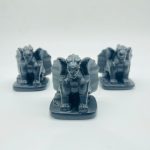Labradorite is a type of feldspar mineral that is known for its iridescent play of colors, which can range from blue to green, yellow, orange, and red. The colors are caused by the way light interacts with the mineral’s internal structure, which is made up of thin layers of different minerals.

What Causes the Color of Labradorite?
The color of labradorite is caused by a phenomenon called labradorescence. This is a type of optical interference that occurs when light waves interact with the mineral’s internal structure. The thin layers of different minerals in labradorite act as a diffraction grating, which causes the light waves to be scattered and reflected in different directions. This scattering of light produces the iridescent play of colors that is characteristic of labradorite.
The color of labradorite can vary depending on the angle at which the light strikes the mineral. This is because the diffraction grating effect is strongest when the light is perpendicular to the layers of minerals in the labradorite.
The Different Colors of Labradorite
Labradorite can display a wide range of colors, including:
- Blue
- Green
- Yellow
- Orange
- Red
- Purple
The most common color of labradorite is blue, but all of the other colors can also be found. The rarest color of labradorite is red, which is why it is often considered to be the most valuable.
The Uses of Labradorite
Labradorite is a popular gemstone that is used in a variety of jewelry and decorative objects. It is also used in some metaphysical applications, as it is believed to have healing and protective properties.
The Value of Labradorite
The value of labradorite can vary depending on the size, color, and quality of the stone. The largest and most colorful labradorite stones are the most valuable.
Caring for Labradorite
Labradorite is a relatively soft mineral, so it is important to take care when wearing or cleaning it. Avoid exposing labradorite to harsh chemicals or extreme temperatures. To clean labradorite, use a mild soap and water solution and a soft cloth.
Interesting Facts About Labradorite
- Labradorite is named after the Labrador Peninsula in Canada, where it was first discovered.
- Labradorite is a member of the feldspar group of minerals.
- Labradorite is the state gemstone of Oregon.
- Labradorite is said to have healing and protective properties.
- Labradorite is a popular gemstone that is used in a variety of jewelry and decorative objects.
Table 1: The Different Colors of Labradorite
| Color | Wavelength (nm) |
|---|---|
| Blue | 450-495 |
| Green | 500-565 |
| Yellow | 570-590 |
| Orange | 595-620 |
| Red | 625-700 |
| Purple | 700-750 |
Table 2: The Value of Labradorite
| Size (carats) | Color | Quality | Value (USD) |
|---|---|---|---|
| 0.5-1 | Blue | Good | $10-$20 |
| 1-2 | Blue | Good | $20-$40 |
| 2-3 | Blue | Good | $40-$60 |
| 3-5 | Blue | Good | $60-$100 |
| 5+ | Blue | Good | $100+ |
Table 3: Caring for Labradorite
| Care Instruction | Importance |
|---|---|
| Avoid harsh chemicals | Harsh chemicals can damage the surface of labradorite. |
| Avoid extreme temperatures | Extreme temperatures can cause labradorite to crack or break. |
| Clean with a mild soap and water solution | A mild soap and water solution is the best way to clean labradorite. |
| Use a soft cloth | A soft cloth will help to prevent scratching the surface of labradorite. |
Table 4: Interesting Facts About Labradorite
| Fact | Source |
|---|---|
| Labradorite is named after the Labrador Peninsula in Canada. | Wikipedia |
| Labradorite is a member of the feldspar group of minerals. | Mindat |
| Labradorite is the state gemstone of Oregon. | Oregon State Parks |
| Labradorite is said to have healing and protective properties. | Crystal Vaults |
| Labradorite is a popular gemstone that is used in a variety of |




























